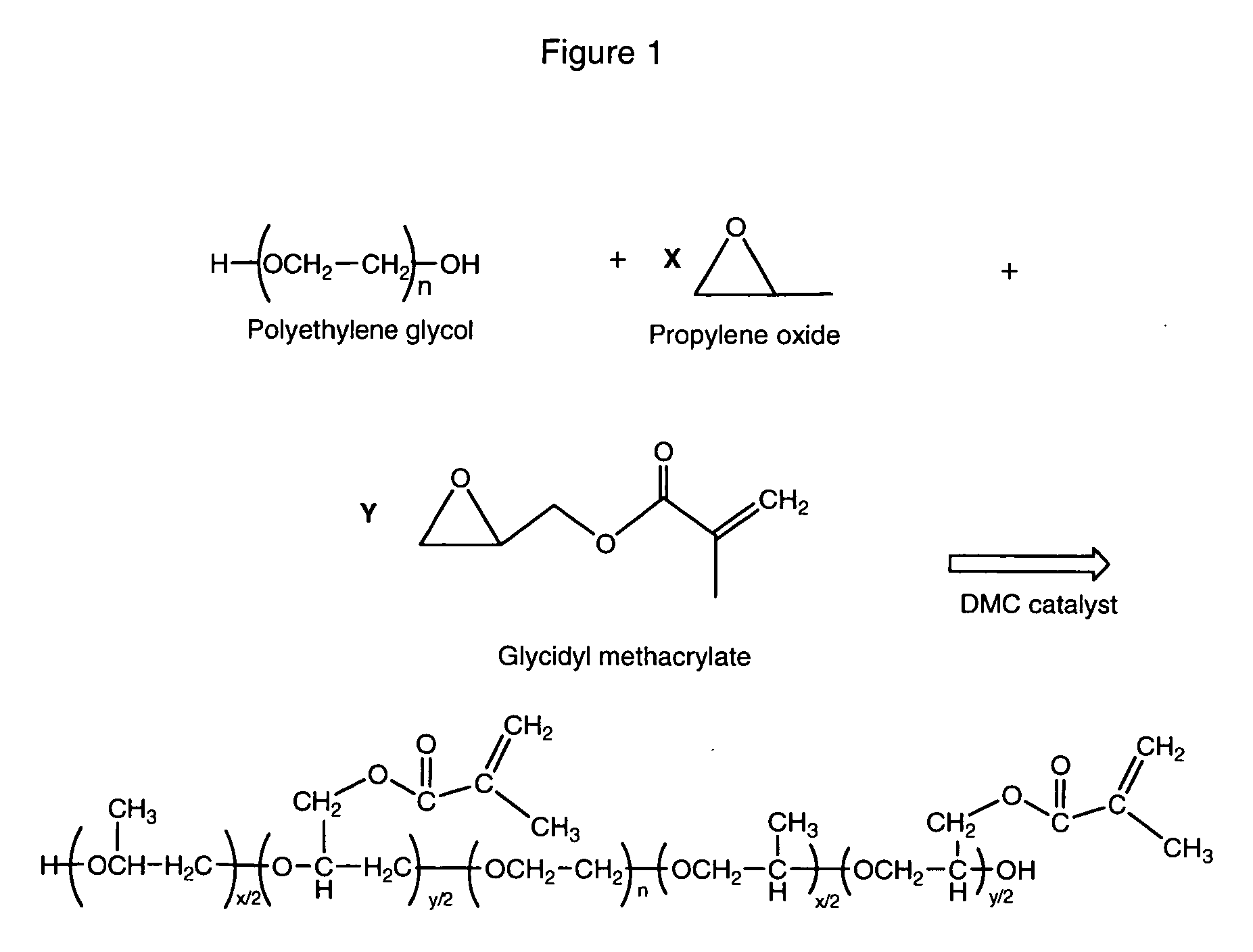Pendant acrylate and/or methacrylate-containing polyether monols and polyols
- Summary
- Abstract
- Description
- Claims
- Application Information
AI Technical Summary
Benefits of technology
Problems solved by technology
Method used
Image
Examples
example 1
Preparation of 2500 MWEO / GMA Copolymer With 8 Moles GMA
[0063]PPG-425 (106 g) and toluene (125 g) were charged into a 1-liter reactor along with phenothiazine (0.06 g) and the DMC catalyst (0.075 g). The reaction mixture was heated under vacuum with stirring and a nitrogen purge to −70° C., at which point toluene began to distill of and be collected in the chilled vacuum trap. After removing ˜10 grams of toluene in this manner, the vacuum valve was blocked and the reaction mixture heated to 120° C. EO (18 g) and glycidyl methacrylate (23 g) were fed into the reactor. After activation, which was evidenced by a rapid drop in reactor pressure, the reaction mixture was cooled to 110° C. and EO (213 g) and GMA (261 g) were fed into the reactor at 1.8 and 2.2 g / min., respectively. At the completion of the feed, the temperature was lowered to 100° C., and the reaction mixture was stirred at this temperature for 30 minutes, prior to a 30 minute vacuum strip. The contents of the reactor, a pa...
example 2
Preparation of 2000 MWPO / GMA Copolymer With 4 Moles GMA
[0064]PPG-425 (170 g) was charged into a 1-liter reactor along with Firstcure NPAL (0.08 g; 100 ppm) and the DMC catalyst (0.08 g; 100 ppm). The reaction mixture was heated under vacuum (0.5 psia) with stirring and a nitrogen purge to 120° C. A mixture of PO:GMA (64:36 pbw) was prepared in a pope vessel to facilitate the co-feed of PO and GMA. After 30 minutes stripping, the vacuum valve to the reactor was blocked and 28 grams of the PO:GMA mixture were fed into the reactor at 10 g / min. After activation, which was evidenced by a rapid drop in reactor pressure, the reaction mixture was cooled to 110° C. and an additional 602 grams of the PO:GMA mixture were fed at a rate of 4 g / min. The total feed consisted of PO (402 g) and GMA (228 g). At the completion of the feed, the temperature was lowered to 100° C., and the reaction mixture was stirred at this temperature for 30 minutes, prior to a 30 minute vacuum strip. The contents of ...
example 3
Preparation of 2000 MWEO / GMA Copolymer With 4 Moles GMA
[0065]PPG-425 (170 g) was charged into a 1-liter reactor along with Firstcure NPAL (0.08 g; 100 ppm) and the DMC catalyst (0.08 g; 100 ppm). The reaction mixture was heated under vacuum (0.5 psia) with stirring and a nitrogen purge to 120° C. After 30 minutes stripping, the vacuum valve was blocked and 20 psia of nitrogen was added to the reactor. EO (18 g) was fed into the reactor at 5 g / min. After activation, which was evidenced by a rapid drop in reactor pressure, the reaction mixture was cooled to 110° C. and a EO (384 g) and GMA (228 g) were co-fed into the reactor at feed rates of 2.5 and 1.5 g / min., respectively. At the completion of the feed, the temperature was lowered to 100° C., and the reaction mixture was stirred at this temperature for 30 minutes, prior to a 30 minute vacuum strip. The contents of the reactor, a nearly colorless, low viscosity liquid (761 g; 95 % yield) were collected for analysis.
[0066]Table 1 sho...
PUM
| Property | Measurement | Unit |
|---|---|---|
| Temperature | aaaaa | aaaaa |
| Temperature | aaaaa | aaaaa |
| Angle | aaaaa | aaaaa |
Abstract
Description
Claims
Application Information
 Login to View More
Login to View More - R&D
- Intellectual Property
- Life Sciences
- Materials
- Tech Scout
- Unparalleled Data Quality
- Higher Quality Content
- 60% Fewer Hallucinations
Browse by: Latest US Patents, China's latest patents, Technical Efficacy Thesaurus, Application Domain, Technology Topic, Popular Technical Reports.
© 2025 PatSnap. All rights reserved.Legal|Privacy policy|Modern Slavery Act Transparency Statement|Sitemap|About US| Contact US: help@patsnap.com

